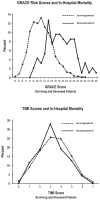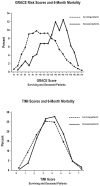Does simplicity compromise accuracy in ACS risk prediction? A retrospective analysis of the TIMI and GRACE risk scores
- PMID: 19956773
- PMCID: PMC2776353
- DOI: 10.1371/journal.pone.0007947
Does simplicity compromise accuracy in ACS risk prediction? A retrospective analysis of the TIMI and GRACE risk scores
Abstract
Background: The Thrombolysis in Myocardial Infarction (TIMI) risk scores for Unstable Angina/Non-ST-elevation myocardial infarction (UA/NSTEMI) and ST-elevation myocardial infarction (STEMI) and the Global Registry of Acute Coronary Events (GRACE) risk scores for in-hospital and 6-month mortality are established tools for assessing risk in Acute Coronary Syndrome (ACS) patients. The objective of our study was to compare the discriminative abilities of the TIMI and GRACE risk scores in a broad-spectrum, unselected ACS population and to assess the relative contributions of model simplicity and model composition to any observed differences between the two scoring systems.
Methodology/principal findings: ACS patients admitted to the University of Michigan between 1999 and 2005 were divided into UA/NSTEMI (n = 2753) and STEMI (n = 698) subpopulations. The predictive abilities of the TIMI and GRACE scores for in-hospital and 6-month mortality were assessed by calibration and discrimination. There were 137 in-hospital deaths (4%), and among the survivors, 234 (7.4%) died by 6 months post-discharge. In the UA/NSTEMI population, the GRACE risk scores demonstrated better discrimination than the TIMI UA/NSTEMI score for in-hospital (C = 0.85, 95% CI: 0.81-0.89, versus 0.54, 95% CI: 0.48-0.60; p<0.01) and 6-month (C = 0.79, 95% CI: 0.76-0.83, versus 0.56, 95% CI: 0.52-0.60; p<0.01) mortality. Among STEMI patients, the GRACE and TIMI STEMI scores demonstrated comparably excellent discrimination for in-hospital (C = 0.84, 95% CI: 0.78-0.90 versus 0.83, 95% CI: 0.78-0.89; p = 0.83) and 6-month (C = 0.72, 95% CI: 0.63-0.81, versus 0.71, 95% CI: 0.64-0.79; p = 0.79) mortality. An analysis of refitted multivariate models demonstrated a marked improvement in the discriminative power of the TIMI UA/NSTEMI model with the incorporation of heart failure and hemodynamic variables. Study limitations included unaccounted for confounders inherent to observational, single institution studies with moderate sample sizes.
Conclusions/significance: The GRACE scores provided superior discrimination as compared with the TIMI UA/NSTEMI score in predicting in-hospital and 6-month mortality in UA/NSTEMI patients, although the GRACE and TIMI STEMI scores performed equally well in STEMI patients. The observed discriminative deficit of the TIMI UA/NSTEMI score likely results from the omission of key risk factors rather than from the relative simplicity of the scoring system.
Conflict of interest statement
Figures





Similar articles
-
[Comparison of the predictive value of the modified CADILLAC, GRACE and TIMI risk scores for the risk of short-term death in patients with acute ST segment elevation myocardial infarction after percutaneous coronary intervention].Zhonghua Wei Zhong Bing Ji Jiu Yi Xue. 2023 Mar;35(3):299-304. doi: 10.3760/cma.j.cn121430-20220727-00696. Zhonghua Wei Zhong Bing Ji Jiu Yi Xue. 2023. PMID: 36916344 Chinese.
-
TIMI, GRACE and alternative risk scores in Acute Coronary Syndromes: a meta-analysis of 40 derivation studies on 216,552 patients and of 42 validation studies on 31,625 patients.Contemp Clin Trials. 2012 May;33(3):507-14. doi: 10.1016/j.cct.2012.01.001. Epub 2012 Jan 11. Contemp Clin Trials. 2012. PMID: 22265976 Review.
-
Epidemiology and risk factors of patients with types of acute coronary syndrome presenting to a tertiary care hospital in Sri Lanka.BMC Cardiovasc Disord. 2019 Oct 21;19(1):229. doi: 10.1186/s12872-019-1217-x. BMC Cardiovasc Disord. 2019. PMID: 31638908 Free PMC article.
-
Comparison of GRACE and TIMI risk scores in the prediction of in-hospital and long-term outcomes among East Asian non-ST-elevation myocardial infarction patients.BMC Cardiovasc Disord. 2022 Jan 7;22(1):4. doi: 10.1186/s12872-021-02311-z. BMC Cardiovasc Disord. 2022. PMID: 34996365 Free PMC article.
-
Contemporary NSTEMI management: the role of the hospitalist.Hosp Pract (1995). 2020 Feb;48(1):1-11. doi: 10.1080/21548331.2020.1701329. Epub 2020 Feb 20. Hosp Pract (1995). 2020. PMID: 31815570 Review.
Cited by
-
Discrepancy between clinician and research assistant in TIMI score calculation (TRIAGED CPU).West J Emerg Med. 2015 Jan;16(1):24-33. doi: 10.5811/westjem.2014.9.21685. Epub 2014 Nov 11. West J Emerg Med. 2015. PMID: 25671004 Free PMC article.
-
Anemia and Inflammation in ST-Segment Elevation Myocardial Infarction.Am J Med Sci. 2015 Jun;349(6):493-8. doi: 10.1097/MAJ.0000000000000471. Am J Med Sci. 2015. PMID: 25978119 Free PMC article.
-
Contemporary Revascularization Dilemmas in Older Adults.J Am Heart Assoc. 2020 Feb 4;9(3):e014477. doi: 10.1161/JAHA.119.014477. Epub 2020 Jan 24. J Am Heart Assoc. 2020. PMID: 31973608 Free PMC article. Review. No abstract available.
-
Prognostic value of shock index in patients admitted with non-ST-segment elevation myocardial infarction: the ARIC study community surveillance.Eur Heart J Acute Cardiovasc Care. 2021 Oct 27;10(8):869-877. doi: 10.1093/ehjacc/zuab050. Eur Heart J Acute Cardiovasc Care. 2021. PMID: 34263294 Free PMC article.
-
A Comparison of TIMI (Thrombolysis in Myocardial Infarction) and GRACE (Global Registry of Acute Coronary Events) Scores, Myocardial Blush Grade, and Shock Index-Based Indices for Predicting Outcomes in STEMI Patients Undergoing Reperfusion.Cureus. 2025 May 27;17(5):e84938. doi: 10.7759/cureus.84938. eCollection 2025 May. Cureus. 2025. PMID: 40585749 Free PMC article.
References
-
- Anderson JL, Adams CD, Antman EM, Bridges CR, Califf RM, et al. ACC/AHA 2007 guidelines for the management of patients with unstable angina/non ST-elevation myocardial infarction: a report of the American College of Cardiology/American Heart Association Task Force on Practice Guidelines (Writing Committee to Revise the 2002 Guidelines for the Management of Patients With Unstable Angina/Non ST-Elevation Myocardial Infarction): developed in collaboration with the American College of Emergency Physicians, the Society for Cardiovascular Angiography and Interventions, and the Society of Thoracic Surgeons: endorsed by the American Association of Cardiovascular and Pulmonary Rehabilitation and the Society for Academic Emergency Medicine. Circulation. 2007;116:e148–304. - PubMed
-
- Antman EM, Cohen M, Bernink PJ, McCabe CH, Horacek T, et al. The TIMI risk score for unstable angina/non-ST elevation MI: A method for prognostication and therapeutic decision making. JAMA. 2000;284:835–842. - PubMed
-
- Sabatine MS, Morrow DA, Giugliano RP, Murphy SA, Demopoulos LA, et al. Implications of upstream glycoprotein IIb/IIIa inhibition and coronary artery stenting in the invasive management of unstable angina/non-ST-elevation myocardial infarction: a comparison of the Thrombolysis In Myocardial Infarction (TIMI) IIIB trial and the Treat angina with Aggrastat and determine Cost of Therapy with Invasive or Conservative Strategy (TACTICS)-TIMI 18 trial. Circulation. 2004;109:874–880. - PubMed
-
- Yan AT, Yan RT, Tan M, Eagle KA, Granger CB, et al. In-hospital revascularization and one-year outcome of acute coronary syndrome patients stratified by the GRACE risk score. Am J Cardiol. 2005;96:913–916. - PubMed
-
- Morrow DA, Antman EM, Charlesworth A, Cairns R, Murphy SA, et al. TIMI risk score for ST-elevation myocardial infarction: A convenient, bedside, clinical score for risk assessment at presentation: An intravenous nPA for treatment of infarcting myocardium early II trial substudy. Circulation. 2000;102:2031–2037. - PubMed
Publication types
MeSH terms
LinkOut - more resources
Full Text Sources

